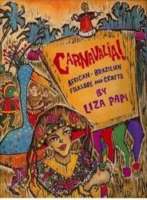
Carnavalia! African-Brazilian Folklore and Crafts
Written and illustrated by Liza Papi
Diane Publishing Company, 1994, 48 pp.
ISBN: 978-084781779
This story begins when a group of people dressed in costumes and carrying instruments come to Nanny’s house to sing on Christmas Eve. Nanny explains to Mourrice, her seven-year-old grandson, that what he is seeing is part of the Reisado, a celebration announcing the arrival of the Messiah. This celebration marks the beginning of a joyful season with many more festivities and ending with Carnival. The next celebration that Mourrice learns about is Bumba-meu-Boi, a tale told through the music. The costumes and drumming involve a Bull that dies and is brought back to life. Following this celebration is Frevo where Mourrice, Nanny, neighbors, and friends participate in holding colorful umbrellas and moving to the driving rhythm of the drums, dancing in the streets of their northeastern Brazilian village. After that, Mourrice dresses up in different costumes and participates in the Congo and Mozambique dances along with his grandmother and other people, celebrating St. Benedict, the patron saint of the African descendants. Finally Maracatú, a celebration that honors some of the African-Brazilian ancestors who were once kings, closes this joyful season for Mourrice and Nanny.
Brazilian artist Liza Papi translates the energy and the tradition of northeastern Brazil into her vibrant, hand-colored, woodcut prints. Papi was born in Brazil, studied art at Guignard Fine Art School, in Belo Horizonte, Brazil and received a bachelor’s degree in art history. Later, she obtained a master of fine arts in printmaking from the City College of New York. Her work has been exhibited in the Museum of Modern Art of Rio de Janeiro and in galleries in New York and Europe. During her research for this book, Papi was mostly influenced by professionals who are closely related to arts and crafts or dance performances. Along with the story, she provides the history of Brazil and a section on crafts that guides children in creating their own carnival crafts.
The chronological structure of the story and a simple and easy to follow text along with detailed captivating illustrations allow readers to experience important regional traditions that take place during a short period of time. Papi as an illustrator and author approached this book from an insider’s perspective of Brazilian culture and emphasizes multiple cultures that coexist within Brazil. Introducing the African-Brazilian culture as one of the unique cultures in Brazil, Papi weaves a powerful theme of multiculturalism within Brazil through the story of a young boy who enjoys the festivities. In addition to all of the rich historical information and cultural details, Papi reflects the Brazilian culture through her retelling of the ceremonies while highlighting relationships. Her skillful illustrations and vivid portrayals indicate that she spent time researching in order to provide various aspects of African-Brazilian traditions. More importantly, she brings to the forefront the importance of the elders passing on their knowledge and wisdom to the young generation, offering numerous possibilities for discussions on the strength of values and traditions.
Although the author is from Brazil, positioning herself as an insider, cultural authenticity and accuracy is of concern. When it comes to the content of the book, the author appears to have generalized some religious traditions as part of the carnival and changed the date of Maracatú, from June to February. What’s more, the author seems to pay little attention to situating the book in a specific region of the northeast Brazil that holds the celebrations described in the book, insinuating that these festivities are celebrated all over the northeastern regions. Some of her translations in terms of her word choices, such as flag instead of banner, are problematic for insiders. So, her cultural accuracy, in some instances, will be debatable for insiders from that region of Brazil, even though these issues will probably not be recognized by outsiders.
Some details that are inaccurate include berimbau, an instrument that is placed in a celebration in the book that does not call for one, a character dressed up in costume of another celebration, an overuse of black on the illustrations, and the lack of other colors in some costumes. Inaccurate representations of particular artifacts that are presented in the book may be confusing to Brazilian insiders. Despite having an insider’s perspective, the author’s misrepresentations and misinterpretations could create issues and concerns about cultural authenticity and result in the reader’s perception that the author lacks familiarity with that specific region of Brazil. It is especially concerning that many outsider readers may celebrate the uniqueness of Brazilian culture without attention to the multiple Brazilian traditions and cultures. There is no one insider cultural tradition in Brazil and the author has failed to recognize this issue in her own research.
This story by Brazilian illustrator/author Papi might appeal to families and children in many parts of the world who have experienced the effects of colonialism and cultural miscegenation and to Brazilian-American children who have few resources about their culture available in English. Other related books that address the Brazilian culture, history, and folklores include Brazil: The Culture (Malika Hollander, 2003), Victory Goes to Brazil (Maria De Fatima Campos, 2009), Dancing Turtle: A Folktale from Brazil (Pleasant DeSpain, 2005), The Mystery of Samba: Popular Music and National Identity in Brazil (Hermano Vianna, 1999).
Enhye Lee, University of Arizona, Tucson, AZ
Alzira Duncan, University of Arizona, Tucson, AZ
WOW Review, Volume V, Issue 3 by Worlds of Words is licensed under a Creative Commons Attribution-NonCommercial-ShareAlike 4.0 International License. Based on work at https://wowlit.org/on-line-publications/review/v-3/
